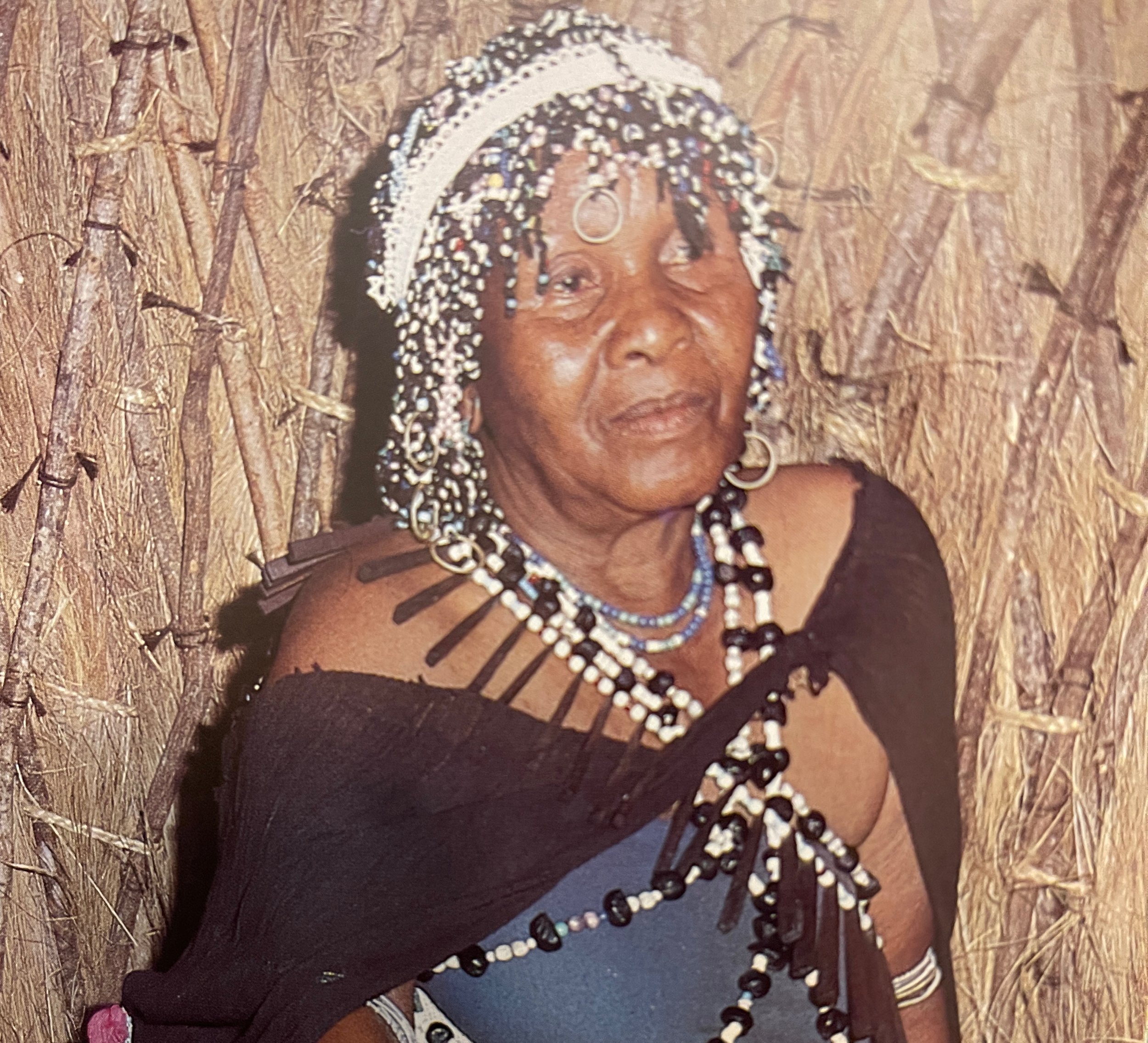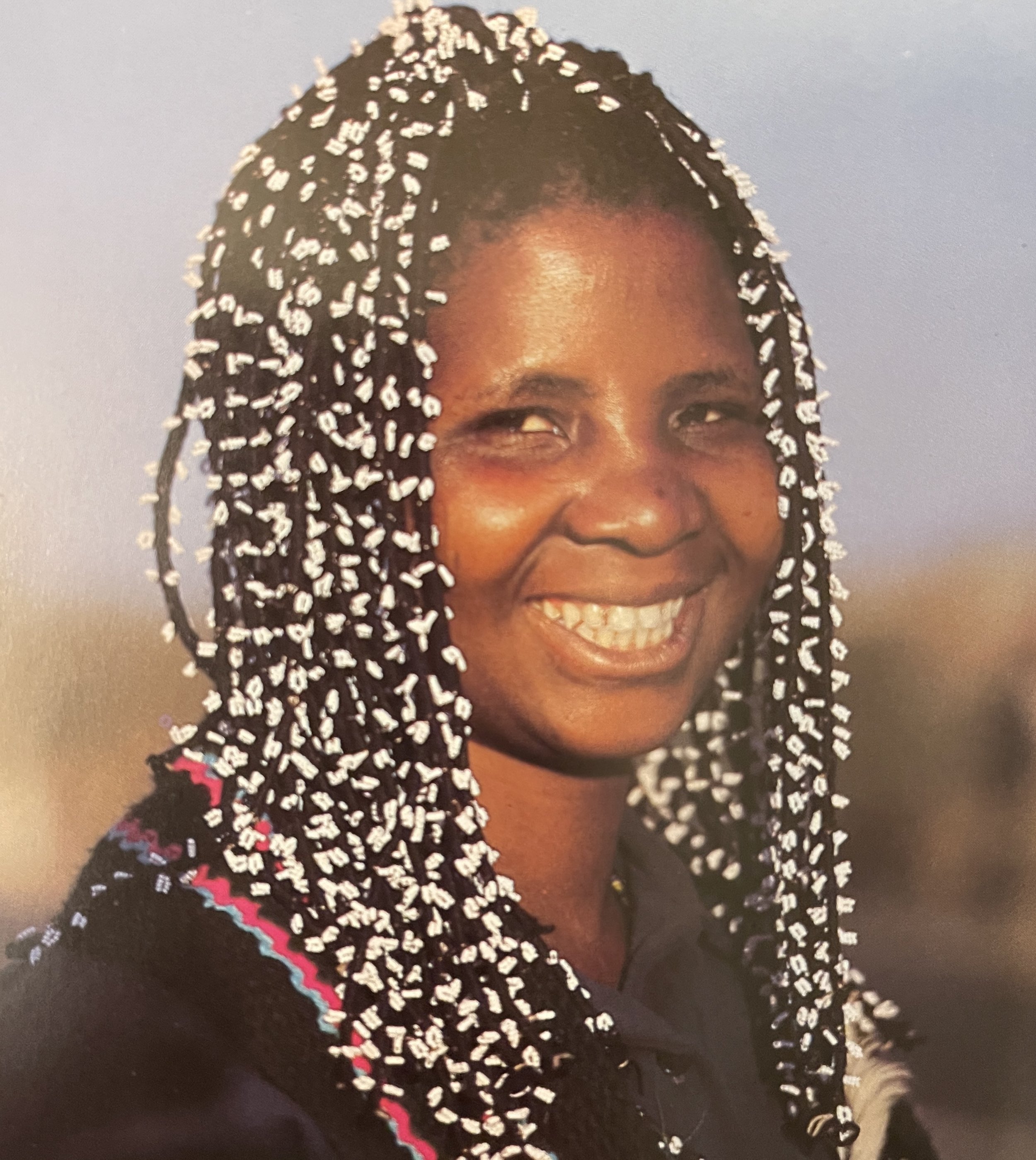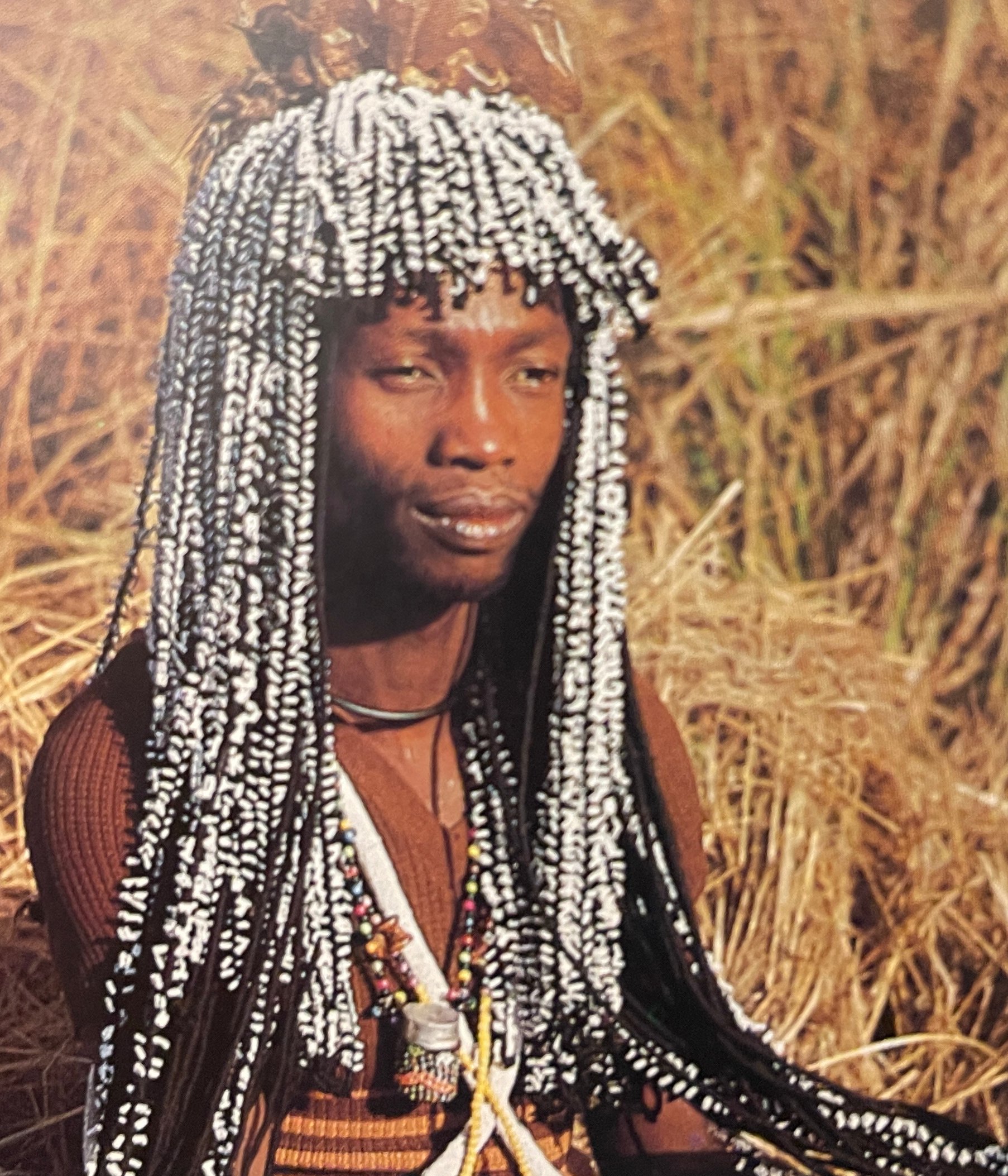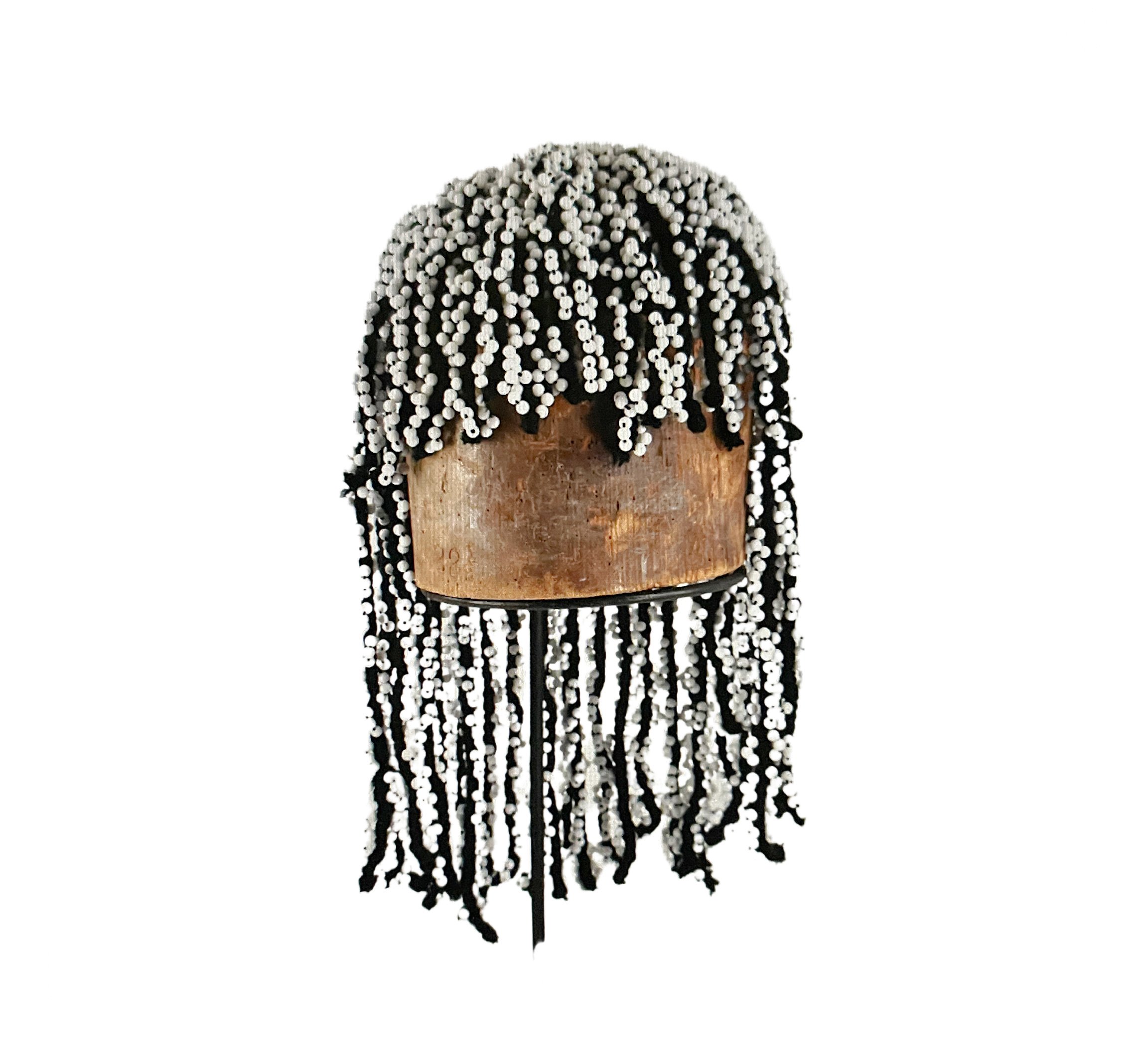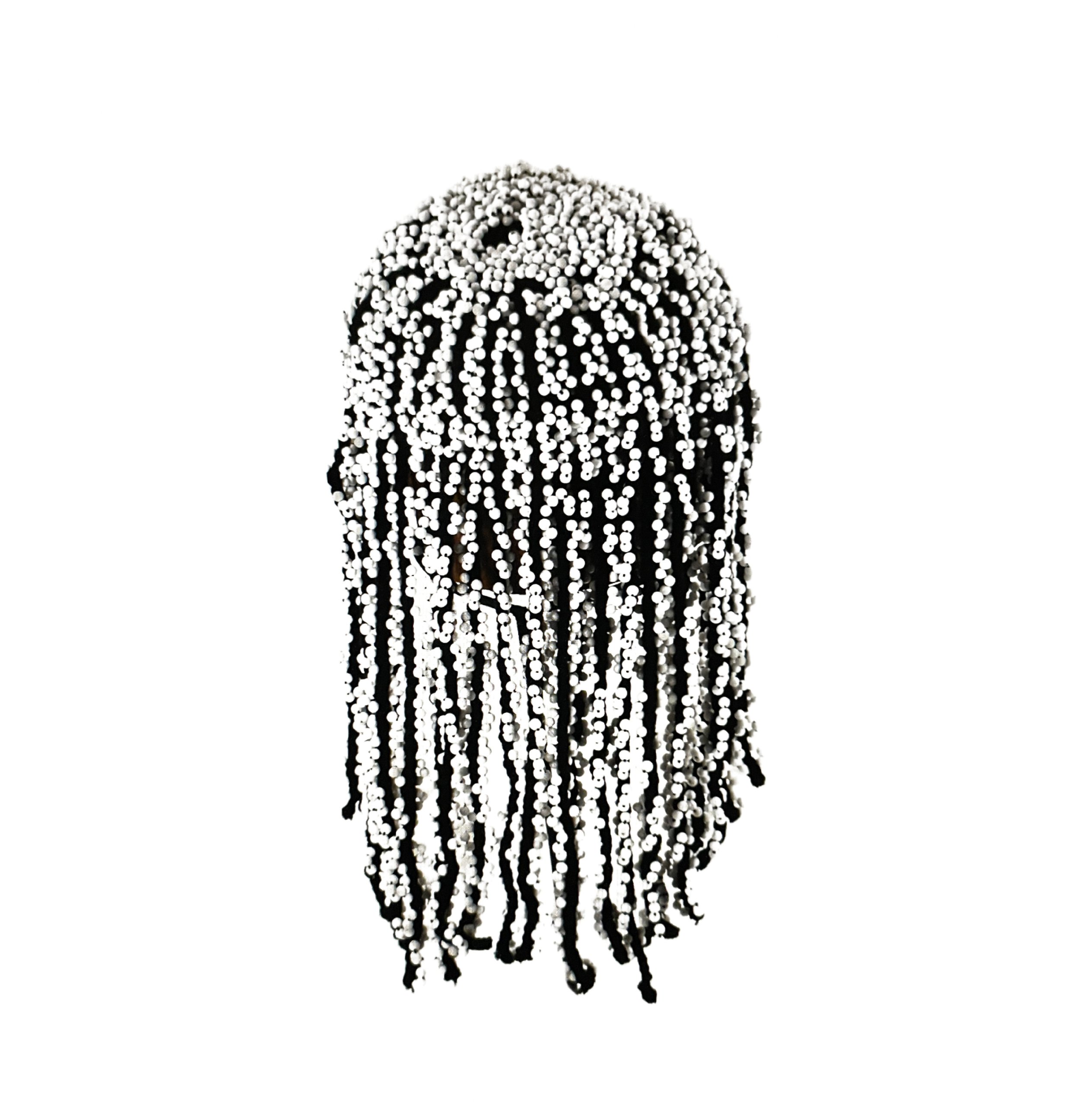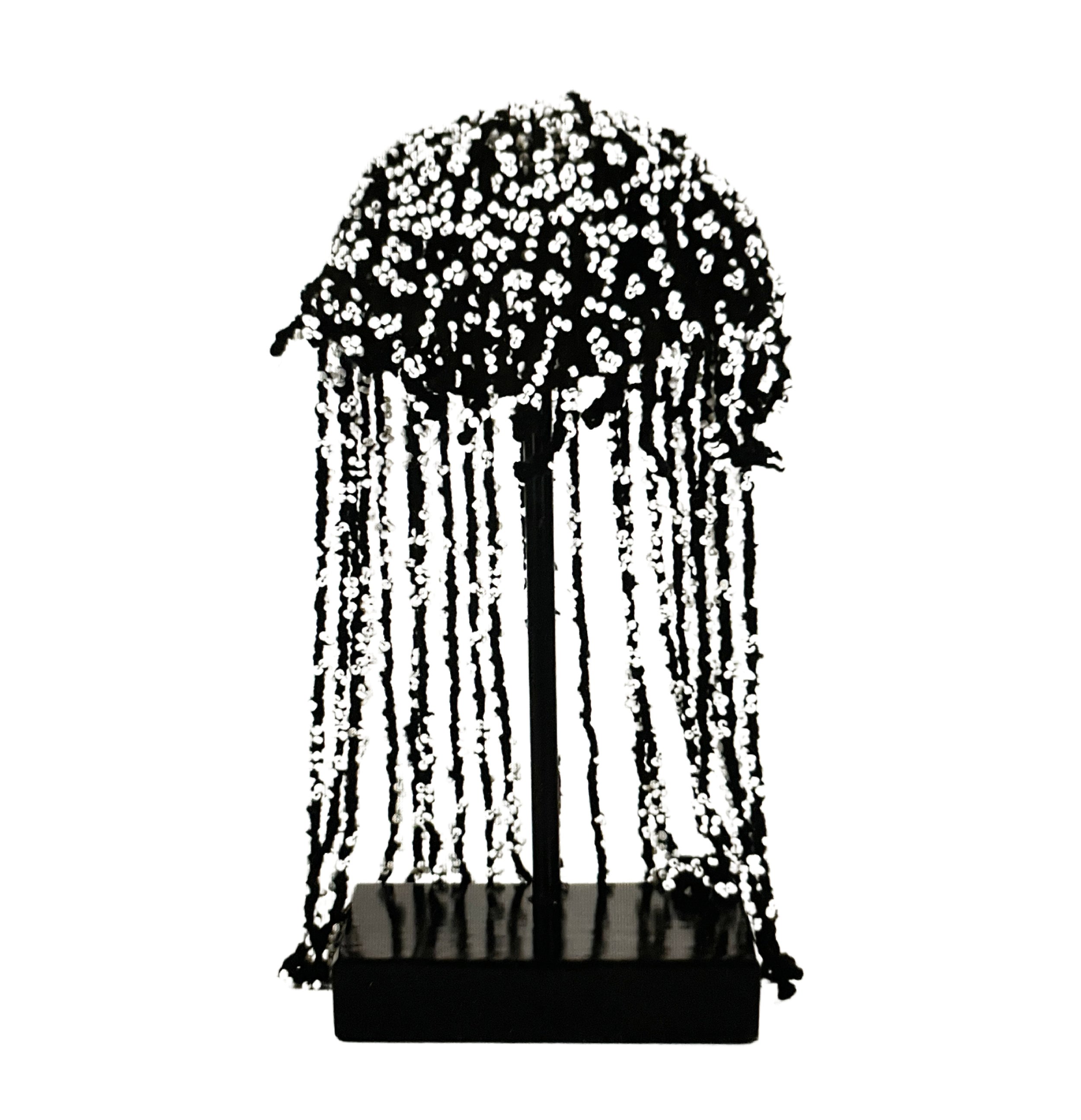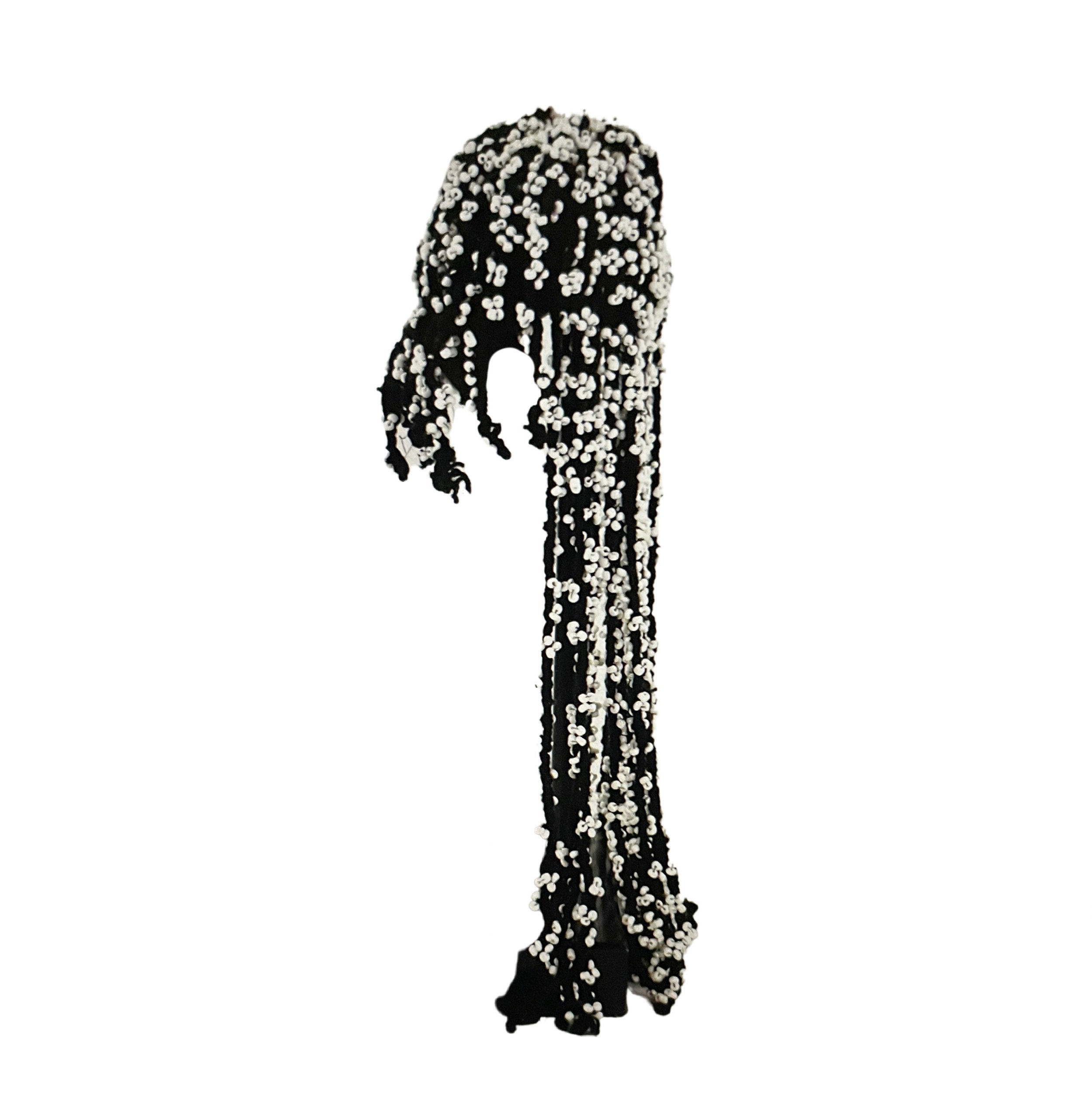Zulu Beaded Sangoma Headdresses
Zulu Sangoma (traditional diviner or healer) with a beaded headdress or wig. South Africa, ca. 1970s. Photo credit: Jean Morris. From South African Tribal Life Today by Jean Morris and Ben Levitas (CapeTown: College Press, 1984), Fig. 248.
WHY ZULU BEADWORK?
Creativity!
Zulu women are some of the most creative beaders on earth.
In this and other upcoming posts, I’ll be exploring Zulu Beadwork from different points of view.
In this post, we consider Zulu beaded headdresses, especially those worn by traditional healers known as sangoma.
We conclude with a quick tour of beaded headdresses worn by other South African tribes.
What is a Sangoma?
A Traditional Diviner or Healer
In traditional South African traditional cultures, a sangoma is a highly-respected healer, diviner or spiritual practitioner who serves as an intermediary between the everyday world and the realm of the ancestors.
Most sangoma are women, but men can become sangoma too.
The following Youtube video show aspects of sangoma life:
What does “sangoma” mean?
“One Who Practices Ngoma”
Sangoma is a Zulu word meaning “one who practices ngoma,” a set of practices based upon the conviction that ancestors care deeply for living human beings and will gladly offer guidance and protection when properly consulted.
Zulu revere many types of ancestors beyond those in their personal family line. Ancestors of the tribe, the clan and other social groups are also accorded respect.
What do sangoma Do?
Contact Ancestors for Guidance
Contact takes various forms. First, the sangoma must learn about the problem facing the client. Next, the sangoma has to decide which ancestors to contact - and how best to communicate with them. Finally, the sangoma may recommend further steps promoting healing or problem resolution.
Sangomas access ancestral guidance in many different ways, including:
by inviting spirit possession, in which the sangoma, after entering a trance, invites the ancestor to take over his body and provide advice directly to the client.
by engaging in divination, in which the sangoma first casts a handful of small, talismanic objects onto the ground - such as animal bones, rocks, shells, dice or beads - and then interprets the patterns they assume as forms of ancestral wisdom. Each type of object carries a certain significance. For example, a hyena bone in a certain position may reveal the presence of a thief or the whereabouts of stolen objects.
by explaining dreams experienced by either the client or the sangoma.
by conducting purification rituals or animal sacrifices to atone for human misdeeds and persuade the ancestors to listen.
by prescribing herbal medicines or referring the client to a specialized herbalist.
Are sangoma still valued in contemporary South Africa?
Yes, very much so.
Despite belonging to the Christian religion, the majority of modern Zulu and other South African people seek out a sangoma first when facing illness, relationship issues, difficulties with family or work, and a wide range of other concerns.
According to “Traditional Healers of Southern Africa,” in addition to the duties noted above, modern sangoma may be asked to:
lead birth or death rituals
locate missing cattle
neutralize witchcraft
foretell the future
teach Zulu tradition
There are an estimated 200,000 sangoma practicing in South Africa today. To learn more about them, read “Zulu Sangoma.”
Why Do Zulu Sangoma Wear Beads in Their Hair?
To Signify Their Profession
Zulu sangoma ornament themselves in traditional ways that symbolize their profession - much like medical doctors wear lab coats.
Symbols of this nature provide instant recognition of the person’s role in the world.
For the sangoma, beads form one such symbol. Not just the beaded necklaces they wear, but the tiny white beads braided into their hair, a few beads at a time.
Or, instead of having beads braided into their hair, sangoma may opt to wear beaded wigs - as the sangoma shown at the top of this post appears to be doing.
While the origin of this custom may not be known, the color white is signifiant. In Zulu culture, white is associated with the spiritual realm which sangoma may visit while divining or healing.
Above images of three sangoma are from South African Tribal Life Today by Jean Morris and Ben Levitas (Cape Town: College Press, 1984), Figs. 236, 235, 243. Photo credit: Jean Morris.
What Beading Techniques Are Used?
Bead braiding - a form of bead plaiting
The main technique is bead braiding, which is a form of bead plaiting.
For more on bead plaiting and how it differs from bead weaving and other broad categories of beading techniques, please see pages 68-71 of “Bead Netting and Plaiting Techniques in the Peranakan World”, by Valerie Hector.
The beads embellishing a Zulu sangoma’s hair may be braided to form small loops, triangles, or other designs.
It seems that bead placement was not uniform but tailored to an individual sangoma’s preference or to local or lineage traditions. More research is needed to document stylistic differences between sangoma beaded headdresses and wigs.
What about Beaded Sangoma Wigs?
Some Zulu Sangoma Wore Beaded Wigs
Two Zulu beaded sangoma wigs are shown above in Images #1 and #3.
Details of each wig appear in Images #2 and #4 above.
(Additional photos of each wig appear on the Etsy page of Africa Direct. Click here and here. Custom wood or metal stands turn the wigs into works of ethnographic art meant for display in a home or office setting.
Other pieces of Zulu Beadwork are also shown on this page on Africa Direct. Note: Valerie Hector is not affiliated with Africa Direct in any way.)
In some cases, a sangoma might make her or his own beaded wig
In other cases, a sangoma obtained a beaded wig from a person who specialized in the craft.
Being removable, beaded wigs could be taken off for certain occasions - or on extremely hot days.
With Beaded Fringe as a Sign of Respect
When the beaded fringe on such a wig covers the forehead or eyes, it is meant as a gesture of respect for the ancestors - and the people sangoma serve.
Also as a sign of respect, Zulu brides were differently-shaped headdresses or veils with beaded fringe covering their face. (For photos, see below).
Two Young Zulu Women
Training to Become Sangoma
The serious expressions on the faces of these two young women apprentice sangoma are consistent with the weight of their responsibilities they’re learning to face as they adapt to their lifelong role.
From now on, they’ll devote much of their life to seeking guidance from ancestors who can help living people deal with issues, problems and challenges.
Only a few beads appear in these young ladies’ hair.
Presumably, more beads will be added in the future, as they gain additional experience.
Photographed in South Africa, ca. 1960s or 1970s. Photo credit: Jean Morris. From: South African Tribal Life Today, by Jean Morris and Ben Levitas (Cape Town: College Press, 1984), Fig. 253.
How does a person Become a Sangoma?
First, they receive an Ukuthwasa from the ancestors - a calling.
A sangoma must be called to the role.
Only ancestral spirits can issue a calling.
An older, experienced sangoma must then confirm that a calling has been received.
Known as an ukuthwasa, the calling often manifests as an illness typically accompanied by vivid dreams or powerful visions.
An ukuthwasa can happen at any age, to women or men.
Next, They Undergo Training
The calling is just the start.
Months or years of initiation will follow, led by an experienced sangoma.
Initiates spend long periods of time learning the proper methods for divination, healing, ritual sacrifice, and more.
What Else Do Sangoma wear?
Beaded Necklaces, Wildebeest Switches, Chicken Feathers
In addition to beaded headdresses, Zulu sangoma often wear or carry:
long, draping strands of beads that cross over the chest
other beaded necklaces and bracelets
a switch or whisk, traditionally made of the hair of a wildebeest
inflated goat bladders or bunches of chicken feathers on top of a beaded headdress, signifying the animal sacrifices they’ve participated in as a means of contacting ancestors
The photos below show some of these items in use.
A Zulu Sangoma Wearing a Beaded Wig Topped with Inflated Goat Bladders
At right, a Zulu sangoma stands by the roadside on her or his way to a meeting with other diviners. While most of the beads in the headdress are white, a few are yellow, a color symbolizing wealth and fertility in Zulu culture.
Note the inflated goat bladders worn atop the beaded headdress and the large whisk or switch, traditionally made from the tail of a wildebeest. Like the beaded headdress, the whisk symbolizes the sangoma’s profession.
Photographed in South Africa, ca. 1970s. Photo credit: Jean Morris. From South African Tribal Life Today by Jean Morris and Ben Levitas (Cape Town: College Press, 1984).
A Zulu Woman Sangoma Wearing Bunched Chicken Feathers Atop her Head
The white beads in this sangoma’s hair are “worked into the cotton-bound, elongated strands of her hair.” Note the shell-bead bracelets on her wrist and her multicolored bead necklaces. Her headdress is topped with chicken feathers.
Photographed in South Africa, ca. 1970s. Photo credit: Jean Morris. Photo and quotation from South African Tribal Life Today by Jean Morris and Ben Levitas (Cape Town: College Press, 1984), Fig. 233.
A Woman Sangoma Wearing a Wide Beaded Necklace
In addition to wearing white beads in her hair, the woman wears a wide beaded necklace. The expression on her face may stem from the seriousness of her duties as an intermediary between the realms of ancestors and mortals. As noted above, Zulu people associate the color white with the spirital realm.
Photographed in the Tugela Ferry area of KwaZulu-Natal, South Africa, ca 1960s or 1970s. Photo credit: Aubrey Elliott. From Sons of Zulu by Aubrey Elliott (London: Collins, 1978), Page 25.
Did Sangoma Wear Other Bead Colors in their hair?
Yes.
A Sangoma with Multicolor Beads in her hair, Ca. 1972
A Zulu woman sangoma with large plastic beads in her wig or hair.
Why did she opt for muticolored beads?
Did other sangoma of her clan also style their hair in this way?
Or did her location in Durban - a large city - influence her choice of beads?
A beaded necklaces and a wide beaded belt complete her beadwork ensemble.
Photographed in Durban, South Africa, in 1972. Photographer unknown. From Speaking with Beads: Zulu Arts from Southern Africa by Jean Morris and Eleanor Preston-Whyte (New York: Thames and Hudson, Inc., 1994), page 41.
Zulu Woman Sangoma with Multicolor Beads in Her Hair,
Ca. 2016
This Zulu sangoma wears a beaded headdress made with red and white beads. In traditional Zulu culture, red signifies strong emotions, while white, as mentioned above, is associated with ancestral realms. Note the switch or whisk in her hand, another symbol of her profession.
Photographed in 2016 at Lesedi Cultural Village just north of Johannesburg in South Africa.
It is unclear whether this woman is merely dressed as a sangoma for the benefit of tourists, or whether she’s a sangoma in real life.
Photo credit: Jane Rix. Courtesy: Shutterstock. Reproduced with permission.
What About Other Zulu Beaded Headdresses?
Zulu Brides Also Wore Beaded Headdresses or Veils
Long beaded fringes hung down from these headdresses, partially or wholly obscuring the bride’s face.
Covering the face in this way was meant as a sign of respect for her husband and father in law.
Such a face-covering forms part of the hlonipha practice governing traditional Zulu gender relations.
However, some interpret hlonipha as part of an old patriarchal order that disadvantages Zulu women.
To read more about hlonipha in contemporary Zulu or South African culture, see:
“Hlonipha and the Rural Zulu Woman,” by Stephanie Rudwick and Magcino Shange in Agenda: Empowering Women for Gender Equity 82 (2009), pages 66-75.
“Hlonipha and the Ambiguous Woman,” by Robert K. Herbert in Anthropos 85 (1990), pages 455-473.
Zulu Bride Wearing a Traditional Beaded Face Veil, Ca. 1960s-1970s
A Zulu bride sitting on the floor of a hut during the 3-day wedding ceremony.
She wears a beaded face covering or veil that signifies respect for her husband and father-in-law.
The beaded face covering forms part of a larger set of hlonipha customs governing gender relations and more in traditional Zulu society.
A band of intricate beadwork also encircles the rim of her hat.
Location: South Africa. Photo credit: Aubrey Elliott. From Sons of Zulu by Aubrey Elliott (London: Collins, 1978), page 183.
Conclusions
In this post, we’ve only begun describing Zulu sangoma.
Yet, we may conclude:
Zulu sangoma expressed their identity by wearing a profusion of tiny beads in their hair, headdress or wig.
Traditionally colored white, the beads linked traditional Zulu sangoma with the spiritual realm they accessed through dreams, divinations, trances or other rituals while seeking guidance from the ancestors.
In fact, one could almost say that without a beaded headdress, a Zulu sangoma would not appear properly well-dressed for the profession.
In recent decades, other colors of beads have found their way into sangoma hair.
Other items worn or carried by traditional Zulu sangoma include beaded necklaces, chicken feathers, goat bladders, and switches or whisks made of wildebeest hair.
There is much more to learn about Zulu sangoma beaded headdresses, Zulu sagoma traditions and beliefs, and Zulu beadwork.
Future blog posts will address other aspects of Zulu beadwork.
To learn more about Zulu culture, try searching the internet - or visiting your local library.
Zulu Sangoma in Full beaded Regalia
A Zulu sangoma wearing spectacular beaded regalia and other traditional symbols of the sangoma profession.
These traditional symbols blend easily with the sangoma’s Western-style garments and belt.
Photographed in South Africa, ca. 1960s or 1970s. Photo credit: Jean Morris. From: South African Tribal Life Today by Jean Morris and Ben Levitas (Cape Town: College Press, 1984), Fig. 248.



